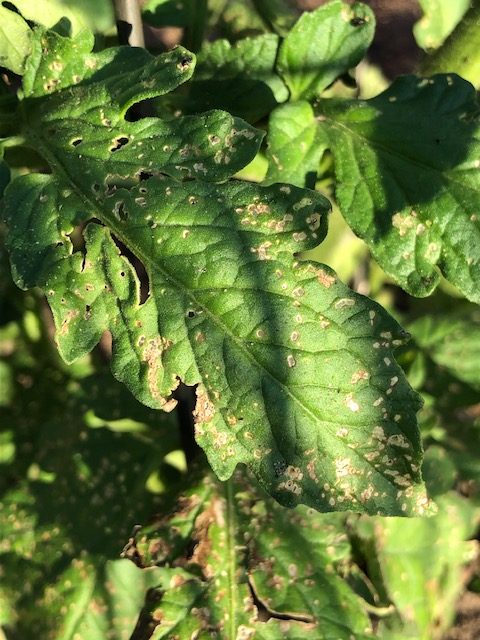Already there are signs of early tomato blight in the several beds and in garden centers all around the Denver Metro Area.
What is early blight?
Tomato blight is a fungus living in the soil. It thrives with moist soil and hot temperatures. Since it is a fungus, it reproduces by releasing spores, which spread with water, similar to molds and other fungi that occur inside houses. The fungus remains in the soil for 3 years and impacts not just tomatoes; other Solanaceae plants, such as potatoes, eggplant and peppers are impacted.
Signs of early blight
Early blight initiates on the lower part of the tomato plant, on the stems and underside of the lower leaves. It progresses up the plant to the leaf surfaces, upper stem and leaves as it spreads.

The initial signs of early blight include small white spots on the stem and lower leaves. As the fungi growth progresses, small brown spots and holes will appear. If you look closely at individual spots, you can see where the fungus started in the center of the spot and spread outward forming concentric rings or a larger brown spot. Entire leaves turn yellow from loss of chlorophyll. Tomato fruits can be severely impacted from the fungus to the point where they are no longer edible or desirable.
Mitigation
Gardeners can do several things to control early blight but early detection and rapid response at the first onset is key. Here are important steps to control early blight over the next 3 years.
- Immediately remove all lower leaves and stems with any sign of blight.
- Do NOT compost blighted plant material. Bag up the blighted leaves and stems for trash.
- Put down overlapping plastic around each plant to cover all soil to prevent soil-water splash and spores from dispersing.
- Use a small amount of mulch on top of plastic to reduce rain impact on the soil. Make sure there is plenty of space between the top of the mulch and the lower plant leaves so they are not touching.
- Water plants at the soil level using drip irrigation nozzles or soaker hoses. Do NOT use sprinklers or other watering methods that sprinkle water around the plant or soil.
- Remove other plant material in bed- especially weeds or other material that can come into close contact with blighted leaves or stems.
- Remove, position or size cloques, wall of water and other other protective surroundings to reduce humidity and temperature around plants.
- Do not disturb soil or work beds when soil is moist or wet.
- Generously spray plants with mix: 3 T baking soda: 1 T oil: several drops dish soap: 1 gallon water to make leaf surfaces with pH 8 (basic); or generously spray fungicide for blight (copper, Chlorothalonil, etc.)
- Do NOT install Solanaceae plants for 3 years in the bed- rotate plant families in your bed.
- As soon as plants senesce in fall, completely clear bed of all plant material, bag and trash plant material. Do not compost.
Early blight can be controlled. Since multiple beds already have signs of blight, we should assume the fungus is throughout the garden. We need to all be vigilant for any signs and collectively do our due diligence in mitigating the impact on our favorite garden fruit.